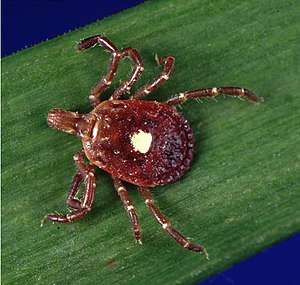Dermacentor albipictus
| Winter tick | |
|---|---|
| Scientific classification | |
| Kingdom: | Animalia |
| Phylum: | Arthropoda |
| Class: | Arachnida |
| Subclass: | Acari |
| Order: | Ixodida |
| Family: | Ixodidae |
| Genus: | Dermacentor |
| Species: | D. albipictus |
| Binomial name | |
| Dermacentor albipictus (Packard, 1869) | |
Dermacentor albipictus, the winter tick, is a species of hard tick that is an external parasite of moose (Alces alces) in North America. Heavy infestations of up to 75,000 ticks[1] have been seen on single moose, and can lead to the death of the animal.[2]
There is evidence that the winter tick may be responsible for a steep decline in the Eastern moose population throughout the southern half of their range.[3] The tick can be found all across North America, and has a large geographic distribution. While it can be found in several different habitats, it is often time located in areas with a presence of moose.[4]
Description
The tick measures up to 15 mm, and is reddish brown in color.[5]
Life cycle
The life cycle of Dermacentor albipictus lasts for about a year, and it is a single-host tick. This means that the entire life cycle of the tick (larvae, nymphs, and adults) progress on a single host animal.[4] First, in late summer larvae hatch from eggs. After laying dormant for some time, they start to ascend vegetation and to group in clusters on plants up to 1.25 m in height. This allows them to latch onto animals that pass by and begin to feed on their host. While on this host, the larvae go through the stages of nymph and then finally transform into an adult. During late winter, the ticks mate, and blood-filled females drop off the host to lay their eggs and die.[5]
Effect on Isle Royale
The tick not only affects moose on Isle Royale , but also other wildlife that can be connected with the moose. In 2001 the moose abundance was around 1200, but due to the tick the moose abundance fell to around 400 in 2007. With the decreased moose population, the main food source of the moose--various shrubs species and balsam fir--has seen an increase in abundance. .[6]
References
- ↑ "What's a Ghost Moose? How Ticks Are Killing an Iconic Animal". National Geographic News. 2015-06-01. Retrieved 2017-03-20.
- ↑ Samuel, Bill (2004). White as a Ghost: Winter Ticks & Moose. Federation of Alberta Naturalists. ISBN 978-0969613466.
- ↑ Hari Sreenivasan (2014-04-07). "What's devastating the wild moose population in New England?". PBS Newshour. Retrieved 2014-04-08.
- 1 2 "Tick Species of Maine - Winter Tick or Moose Tick".
- 1 2 "Moose winter tick".
- ↑ "Small Creature, Big Influence".
